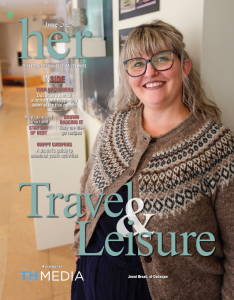As we emerge from our spring COVID-19 cocoons and spread our wings into our new, rapidly shifting normal, Florida recently recorded more than 15,000 COVID-19 cases in one day, and there is a serious quandary about if and how schools will re-open in the fall.
I also am beginning to emerge from my cocoon of deep isolation and grief, after having lost my father to heart disease at the end of January.
I don’t know about you, but I am tired — tired of trying to figure it all out, tired of worrying, tired of not being able to do the things I’ve always done.
I have been trying to take care of myself, to do all the things — exercise, sleep, connect (as much as possible) and, of course, eat. Lots of eating — some of it not all that healthy, I will admit.
Employing food as a coping mechanism is nothing new, of course. We even have a phrase for it: Comfort food, which, in my mind anyway, automatically conjures delicious images of ooey, gooey, cheesy things and rich chocolaty things.
According to an article in the 2017 Journal of Gastronomy and Food Science, we would be pretty much in-step with others’ ideas of comfort food. In that article, comfort food is defined as food that gives us “consolation or a feeling of well-being.”
So clearly, the comfort we are talking about here is emotional comfort. That’s why comfort foods tend to be foods from our childhoods — a time when we are lovingly cared for or they are associated with a person who lovingly cared for us.
When we eat foods associated with these times and these people, we are seeking this sense of mental and emotional well-being we associate with those times.
And so, when we are feeling lonely, sad, stressed or isolated, some of us make an appointment with our two favorite therapists, Ben & Jerry.
I always have been a stress eater. For me, it’s not so much that I crave French fries or chocolate but just anything at all that I can mindlessly crunch on as an acute, almost Pavlovian response to stress.
As a result, it is really easy for me to eat more than what is best for me. This has been an ongoing problem, so I’ve got some great work-arounds in place: I don’t keep a lot of snack foods in the house, I stock up every week on baby carrots, and I thankfully do not have a sweet tooth. But all of those things seem more like a Band-Aid and not a real solution.
There have been periods in my life when I’ve slowed down and cultivated a real awareness of the food I’m nibbling on, but those are punctuated by much longer chapters of mindless munching.
In an effort to make more of an effort in this area, I’ve begun reading a little book that I was gifted a while back. It’s called, “How to Eat,” and it is a series of short meditations on food by Buddhist Zen Master Thich Nhat Hanh. The common thread among of these, is that it takes only a moment — three breaths — to slow down and consider our food and put ourselves in a state of mindfulness.
Here are a few short meditations that really spoke to me:
“With just a little bit of mindfulness, you can truly see where your bread comes from. It has not come from nothing. Bread comes from the wheat fields, from hard work and from the baker, the supplier and the seller. But the bread is more than that. The wheat field needs clouds and sunshine. So, in this slice of bread, there is sunshine, there is cloud, there is the labor of the farmer, the joy of having flour and the skill of the baker. Then, miraculously, there is the bread. The whole cosmos has come together so that this piece of bread can be in your hand. You don’t need to do a lot of hard work to get to this insight. You only need to stop letting your mind carry you away with worrying, thinking and planning.”
Isn’t that beautiful? I feel more mindful, and I’m not even eating right now.
And then, there is this one:
“While we eat, we can try to pay attention to just two things: The food that we’re eating and our friends who are sitting around us and eating with us. This is called mindfulness of food and mindfulness of community. Eating mindfully, we become aware of all the work and energy that has gone into bringing the food to us. If we are eating with others, we can notice how wonderful it is that during this sometimes hectic life, we can find the time to sit together in a relaxed way like this to enjoy a meal. When you can breathe, sit and eat together with your family or friends in mindfulness, this is called true community-building.”
Yes. This is exactly what we hope to achieve through our activities at Convivium Urban Farmstead.
This one is particularly meaningful to me based on my stress-eating issue:
“We don’t need to eat a lot to feel nourished. When we are fully there and alive for every morsel of food, we eat in a way that each bite fills us with peace and happiness. If we are full of this joy, we may find that we naturally feel satisfied with less food.”
And if you are into this type of thing, you might want to try this:
“When the food is on the table and everyone is seated, we (can) practice breathing. ‘Breathing in, I calm my body. Breathing out, I smile’ we repeat three times. We can recover ourselves completely after three breaths like this.”
We can recover ourselves completely. I take a lot of comfort in that.
Leslie Shalabi is the co-founder of Convivium Urban Farmstead, a Dubuque-based nonprofit organization based on the idea of creating community around food. A life-long lover of food and entertaining, she is dedicated to helping people find ways to connect through the universal languages of food and hospitality.

















